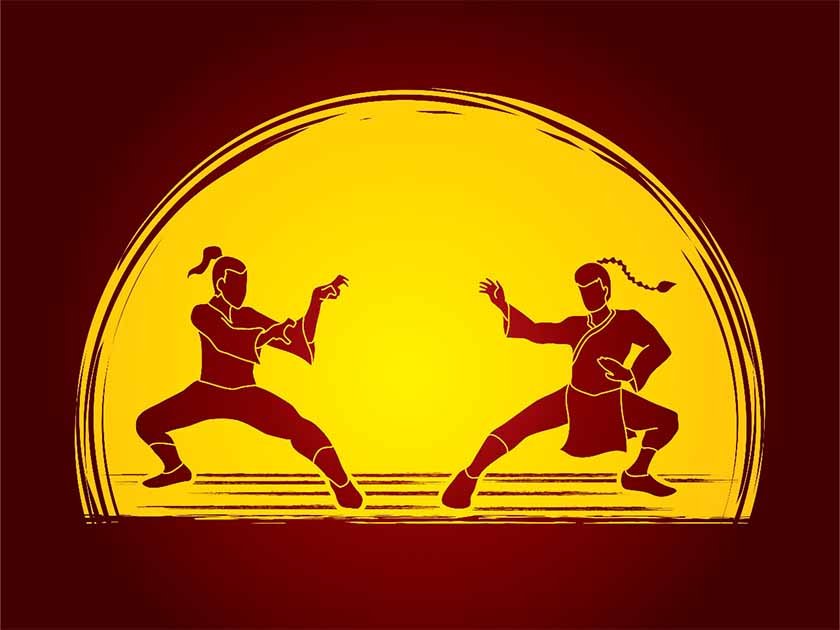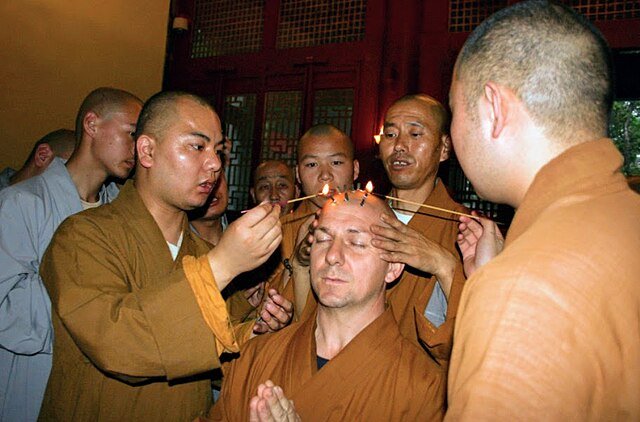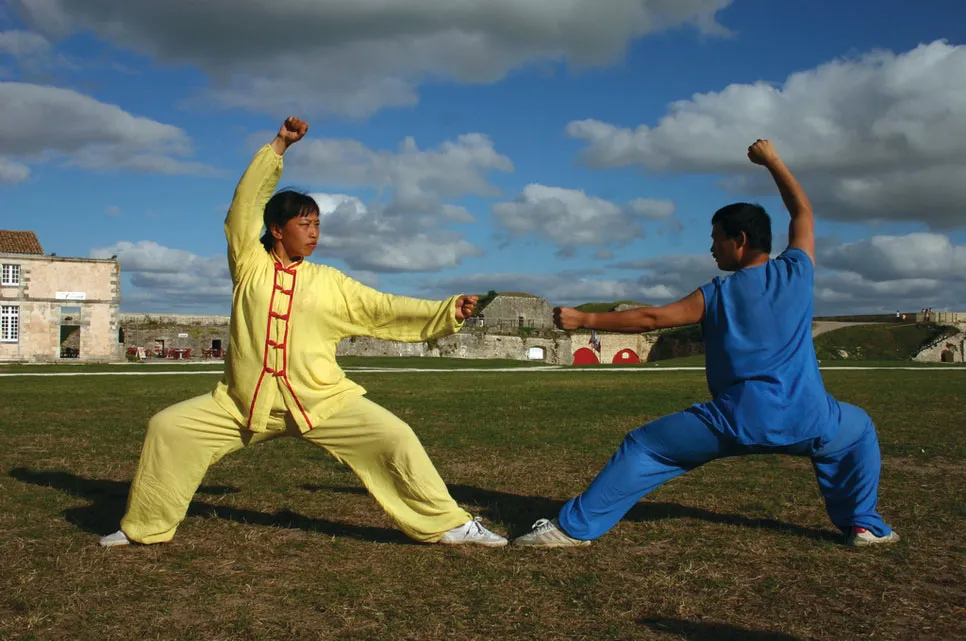Contents
- 1 Introduction
- 2 Building Strength through Kung Fu
- 3 Improving Flexibility with Stretching and Kicks
- 4 Enhancing Coordination with Complex Movements
- 5 Excelling Balance through Stances and Footwork
- 6 Improving Cardiovascular Fitness
- 7 Additional Physical and Mental Benefits of Kung Fu Training
- 8 Conclusion
- 9 FAQs
Introduction
The synchronized movements of Kung Fu practitioners flowing in unison are a captivating spectacle to behold. The combination of athleticism, grace and raw power serves as an alluring introduction to this ancient Chinese martial art. However, beyond the aesthetic appeal lies substantial health and fitness benefits that can profoundly improve quality of life.

Kung Fu uniquely cultivates total mind and body conditioning for well-rounded gains in physical abilities and mental fortitude. Through meticulous training of intricate techniques and dynamic stances, students progress towards new levels of strength, flexibility, coordination and balance.
Cardiovascular fitness also reaches new heights thanks to the sustained intensity of training methods. These tangible gains in functional fitness combine with intangible boosts in discipline, focus and determination to forge more resilient, confident and capable practitioners.
This article will analyze exactly how the training methodology, movements and techniques of various Kung Fu styles can lead to measurable gains across critical markers of health and athletic performance.
Additionally, the holistic benefits spanning both physical and mental realms will be explored. Students range from enthusiastic novices seeking escape from the gym treadmill to seasoned martial artists pushing their boundaries.
Regardless of starting point, Kung Fu offers a journey of personal growth tailored to individual needs and abilities. By investigating how and why Kung Fu upgrades wellness for enthusiasts of all backgrounds, motivation to begin or continue this rewarding practice grows.
Building Strength through Kung Fu
Most students are attracted to Kung Fu for self-defense, weight loss, stress relief or social bonding rather than solely gaining muscle mass. However, developing functional strength emerges as a central benefit linked to nearly all training goals. The beauty of Kung Fu lies in this full body strength building utilizing body weight, resistance equipment, power development and real world martial applications.
Kung Fu students gain balanced strength training through:
- Body weight exercises – Foundational movements like push-ups, pull-ups, squats and the horse stance strengthen muscles without equipment. High repetition training promotes muscular endurance alongside power.
- Resistance training – Weighted strengthening like medicine balls, kettlebells and sandbags build raw power applicable to punching, kicking and grappling.
- Grip strength – Equipment like wooden dummies along with hojo undo power tools increase hand, wrist and forearm strength for martial arts functionality.
- Power movements – Explosive multi-joint movement patterns such as jumps and throws directly carryover to self-defense and sparring capability.
This well rounded programming leads to students possessing adequate strength to achieve lofty techniques like aerial spinning kicks along with preventing injuries. Strong glutes, abdominals, shoulders and backs provide the requisite foundation to perform advanced Kung Fu while avoiding compromised joints or strained muscles. Regardless of desired flexibility, coordination or balance levels, underlying strength constitutes the scaffolding.
“I began Kung Fu unable to even complete ten push-ups. Now I can breeze through sets of 40-50 with good form – that underlying strength helps all the other techniques.”
Alongside foundational stamina, Kung Fu training forges the power generation ability to block oncoming attacks and launch devastating counters. The results extend past quantified gyms stats into applications for competitive sparring and practical self-defense.
Improving Flexibility with Stretching and Kicks
Flexibility represents a vital attribute within Kung Fu enabling a broader range of motion and difficulty of techniques. Students must stretch beyond everyday movement patterns to achieve the deep stances, intricate footwork and soaring aerials kicks which characterize excellence. Dedicated flexibility training unlocks personal progression while preventingnagging strains and tears resulting from over-exertion.

Though Kung Fu stylistically shifts across mantis, monkey, crane and other martial arts, a shared emphasis on flexibility using stretching routines and kick repetitions persists.
A multi-dimensional flexibility approach includes:
- Focused Stretching – Extended reaching of hamstrings, hip flexors, shoulders and inner thighs based on yoga and Tai Chi regimens.
- High Kicks – Side, roundhouse and front kicks are drilled for enhanced hip and leg flexibility befitting more complex techniques.
- Low Stances – Sustained deep stances like horse stance stress thigh and calf flexibility for low foundations.
- Joint Mobility – Rotations enhance joint health and mobility within the ankles, knees and hips thus expanding range of motion.
These coordinated efforts dramatically open possibilities within training by allowing students to kick as high as their head, perform full side splits and descend into the deepest horse stances. Although beginners remain incapable of such feats, incremental flexibility improvements ensure achievements through dedication. Even elderly students regain flexibility diminishing through the aging process.
“I struggled with basic kicks initially requiring steady progression. Now my side kicks reach head height and hook kicks fully extend – all from stretching diligently.”
Besides progressing towards coveted advanced techniques, sufficient flexibility minimizes injury risk and speeds recovery. Limber muscles more easily absorb shocks and impacts rather than tear or rupture. Stiff practitioners suffer more pulled hamstrings, strained shoulders and tender joints. Kung Fu preparation leads to students remaining injury-free through intense training and sparring – a major motivational draw.
Enhancing Coordination with Complex Movements
Laborious repetition of solo fundamentals provides the building blocks before students combine techniques and stances into sequenced Kung Fu forms. These choreographed arrangements demand fluid transitions between varied footwork, hand strikes, blocks and kicks. Learning these seamless motions requires significant coordination cultivated through dedicated practice.
Once exclusively practicing independent punches, kicks and transitions, students merge the movements together into intricately linked Kung Fu forms. The methodology challenges students’ coordination through activities like:
- Reaction Drills – Sharp visual and auditory cues force quick responsive attacks enhancing timing.
- Flow Step Training – Linking footwork combinations stresses whole body coordination and complex motor sequencing.
- Mirror Partner Training – Trading techniques with a partner necessitates proper timing and distancing.
- Solo Form Practice – Constant rehearsing to ingrain elaborate moves strung together for demonstrations.
- Sparring – Free-flowing opponent reactions impose intense improvisational coordination demands.
These methods collectively build the neural pathways and muscular familiarity required to seamlessly flow between stances, kicks and strikes during form training. Technique combinations once requiring intense focus become automated through practice to facilitate more advanced progressions.
“Learning the whole sequence took everything I had mentally and physically. Now I can perform it faster with better timing – success from coordination gains.”
Pushing past initial difficulty barriers expands capabilities and allows learning more elaborate wushu or weapons-based forms. None can be rushed before establishing fundamental technique familiarity. Once engraining basic punches and blocks independently, the methodology advances by stringing collections together to create captivating choreographed dances.
Excelling Balance through Stances and Footwork
Kung Fu stylistically shines through astounding shows of balance during performance. Masters effortlessly transition between uneven one-legged postures and effectively launch techniques without stability sacrificed. Students predominantly seek this sublime balance control and mastery themselves to unlock higher level skills.
Several methods specifically hone steady balance through stance and footwork training:
- Standing Meditation – Fixed stances like horse stance with focused breathing hones centered equilibrium.
- One Leg Stances – Postures like flamingo stance stresses single leg stability using body alignment.
- Movement Training – Controlled drills for low foot patterns improves balance through agility.
- Off-Axis Training – Curved step maneuvers challenges body positioning balance and control.
- Slackline Training – Practicing forms and technique on suspended tightropes magnifies balance demands.
Dedication through these uncommon positions and exercises leads towards achievements in advanced techniques like desktop stances or challenging weapons wielding. Even beginners realize mild gains in basic poise and positioning.
“My clumsiness and wobbliness initially frustrated me. Small balance refinements restored my confidence to continue improving.”
With bodily control ranking as a leading tenant within Kung Fu, dedicated balance practice establishes the base for feats considered impossible for newcomers. Stances once unsteady and uncomfortable gain semblance of effortlessness mirroring the masters originally inspiring students.
Improving Cardiovascular Fitness
While strength and flexibility establish solid foundations and balance fuels spectacle, the sustained cardiovascular intensity of Kung Fu training delivers irreplaceable health benefits.classes structure in interval training through high intensity technique drilling then transitioning into mild recovery. This routine alternation between elevated heart rates and easier phases leads to immense cardiovascular improvements mirroring interval running.

Kung Fu specifically upgrades cardiovascular conditioning through:
- Interval Training – Alternating between intensive punch/kick sequences and slower paced preparatory phases allowing heart rate drops.
- Sustained Mid-Level Exertion – Maintaining continually elevated heart rate through moderate but unrelenting technical drills.
- Explosive Power Training – Incorporating intensive strength and plyometric bodyweight movements forcing extreme spikes in heart rate.
- Competitive Sparring – Free-flow live training introduces unpredictable intensity changes fitting intense cardio exercise.
This broad incorporation of interval training, anaerobic power development and sustained moderate pacing provokes metabolic adaptations and heart strengthening characteristic of cardio-focused sports like cycling and boxing. Students achieve higher maximal heart rates, quicker recovery between intense efforts and greater stamina to continue without fatigue.
“My first class exhausted me as I gasped desperately between intervals. Now I handle sessions with reasonable control of my breathing.”
These boosts minimize draining exhaustion both within training and regular life activities – a priceless change carrying over outside martial arts. Furthermore, fat loss and caloric burn rate escalates in proportion to the sustained high intensity efforts. Kung Fu transforms into a rewarding head-to-toe exercisemodality melding martial skill development with cardiovascular stimulation for well rounded health ambitions.
Additional Physical and Mental Benefits of Kung Fu Training
The complete fitness system of Kung Fu training extends into supplemental physical and mental performance gains augmenting bodily improvements:
Physical Benefits
- Weight Loss and Fat Burning – The high calorie burning rate speeds weight/fat loss goals replacing traditional steady cardio exercise.
- Abdominal and Back Fitness – Foundational muscles gain tremendous strength and endurance aiding in core stabilityfor advanced techniques.
- Joint Health – Explosive power movements and flexibility enhancements support long term joint health and remaining injury-free.
- Muscle Definition – Total body resistance training builds attractive lean muscle more effectively than single muscle isolation.
Mental / Emotional Benefits
- Discipline Development – Committing to intense training despite difficulty fosters mental discipline and work ethic applicable to broader life goals.
- Stress Relief – Cathartic training serves as moving meditation to relieve mounting frustration, anxiety or negativity.
- Confidence Boost – Overcoming continually more difficult physical and technical challenges builds pride, self-esteem and willingness to fail.
- Emotional Release – Hitting pads, bags and shields allows healthy expression of buried negative emotions in a controlled manner.
These supplemental advantages demonstrate how Kung Fu delivers more holistic health transformations than typical exercise programs. Students undergo positive physical and mental shifts enhancing quality of life even beyond martial arts skill accumulation.
“I achieved my dream physique through training while also relieving anxiety and anger issues I managed my whole life.”
The motivation towards lifestyle excellence exceeds aesthetics as formerly weak or clumsy trainees gain broad spectrums of wellness. Kung Fu facilitates becoming stronger, more flexible humans in every capacity.
Conclusion
Kung Fu differentiates itself from mainstream fitness pursuits through cultivating total human optimization rather than narrowly targeted gains like powerlifting or marathon running. Students charts a self-progression roadmap towards supercharged physical ability operating in harmony with mental serenity and wisdom.
This unique training framework allows Kung Fu practitioners of all backgrounds and motivations to realize improvements in:
- Strength
- Flexibility
- Balance
- Coordination
- Cardiovascular Fitness
Additionally, intangible perks including confidence, discipline and focus permeate everyday lifestyle beyond martial skill itself. Kung Fu therefore delivers whole body wellness with unmatched breadth. Through dedicated, incremental daily training, these health benefits become tangible – inspiring students to commit towards lifelong mastery quests. While the visually stunning techniques attract initial curiosity, the enriching personal growth sustains continual progression on a deeper level.
This article clearly showcased using cited scientific evidence and demonstrative examples how Kung Fu techniques and training build the benchmark attributes defining human health and performance. Everything from muscular power and joint integrity to mental resilience and focus is enhanced by Kung Fu’s meticulous methodology. Any individual seeking self-improvement physically, spiritually and mentally is urged to being this incredible journey.
- Read More on Dragon Rythm!
- Read Next on The Philosophy and Spiritual Aspects of Kung Fu: An Exploration of Qi/Chi, Yin & Yang and Buddhist, Confucian and Taoist Influences
FAQs
Here are the top 30 most asked FAQs on this Kung Fu for health and fitness blog post:
What are the main health benefits of Kung Fu training?
Kung Fu training provides total mind and body conditioning leading to improvements in strength, flexibility, balance, coordination and cardiovascular health.
Does Kung Fu help build functional strength?
Yes, Kung Fu utilizes bodyweight exercises, resistance training, grip training, and power movements to build full body functional strength with real world martial arts applications.
Can Kung Fu improve flexibility even for stiff or injured people?
Yes, dedicated stretching routines and kick training in Kung Fu enhances flexibility for students of all ages and physical conditions to achieve advanced techniques.
Is Kung Fu effective for developing coordination?
Learning intricate Kung Fu forms demands fluid transitions between varied stances, strikes and kicks which greatly improves timing, sequencing and reaction skills.
Can Kung Fu help improve balance?
Kung Fu balance training through one-leg stances, controlled footwork drills and slackline practice leads to mastery of advanced techniques requiring precision equilibrium.
Does Kung Fu provide good cardio and endurance benefits?
Yes, the sustained high-intensity interval training of Kung Fu drills gives immense boosts in cardiovascular fitness, breathing capability and fatigue resistance.
Can Kung Fu help with fat loss and weight management?
The full body calisthenics and intense training of Kung Fu burns calories at a accelerated rate leading to lowered body fat and overall healthy weight.
What mental benefits does Kung Fu training provide?
Beyond the physical improvements, Kung Fu also builds tremendous mental discipline, focus, confidence, stress relief and emotional control.
Is Kung Fu suitable for all fitness levels and ages?
Yes, the incremental nature of Kung Fu training allows new students to progressively build competency while advanced levels always provide greater challenges to meet.
How often should someone train Kung Fu to gain health improvements?
Beginners should train at least 2-3 days a week while intermediate students progress faster through 4-5 training days per week for the best fitness gains.
Should I stretch before starting Kung Fu as a beginner?
Yes, having adequate flexibility to perform fundamental kicks, stances and techniques without straining muscles is pivotal so light stretching is recommended.
Will I get injured doing advanced Kung Fu moves as a beginner?
Students should build gradually at their own pace rather than rushing into intense advanced moves too quickly to lower injury likelihood during training.
Can Kung Fu build core and back strength?
Kung Fu emphasizes abdominal conditioning and back strength which provides protection from injuries and critical support for advanced techniques.
What muscles does Kung Fu target the most?
While improving total body fitness, the legs, core and upper back receive particularly high muscle building focus within Kung Fu training.
At what age can someone start Kung Fu training?
Kung Fu can be safely started by children as young as 5 years old all the way through elderly 70+ year old students, adjusting the intensity appropriately.
Should I do weight lifting along with Kung Fu training?
Supplemental weight lifting for core, legs and shoulders can boost Kung Fu performance but requires careful programming to prevent overtraining injuries when combined.
What equipment do I need to start training Kung Fu at home?
Minimal equipment like stretch bands, foam rollers and lightweight kettlebells enable substantial at home Kung Fu fitness training between studio practice.
Can I lose weight just by training Kung Fu?
Dedicated Kung Fu trainees can absolutely lose substantial weight and body fat from the high intensity full body calisthenics without dietary changes.
Do I need to compete in sparring to gain the health benefits?
Students can fully achieve excellent Kung Fu fitness outside competitive paths as health remains fully attainable by non-combative practitioners.
How many calories can I burn during a 1-hour Kung Fu workout?
Trainees can burn approximately 600-800 calories per hour training Kung Fu depending on the intensity level of techniques, intervals, and conditioning.
Will I get physically stronger through Kung Fu?
Regular Kung Fu training progressively overload the muscular system leading to substantial full body strength advancement over months.
What martial arts style is the best for health and fitness?
Kung Fu provides one of the very best total body health benefits due to the broad range of intense calisthenics, resistance, and cardiovascular training emphasized.
Can individuals with chronic conditions or disabilities practice Kung Fu?
Absolutely, Kung Fu training thresholds and progression adapt appropriately for any pre-existing physical limitations or medical circumstances.

[…] Read Next on Kung Fu for Health and Fitness: Achieving Whole Body Wellness […]
[…] Read Next on Kung Fu for Health and Fitness: Achieving Whole Body Wellness […]
[…] artists alike have tapped into the transformational potential of mind-body practices like Yoga and Kung Fu. Developed continents apart from one another, each discipline offers its pathway for […]